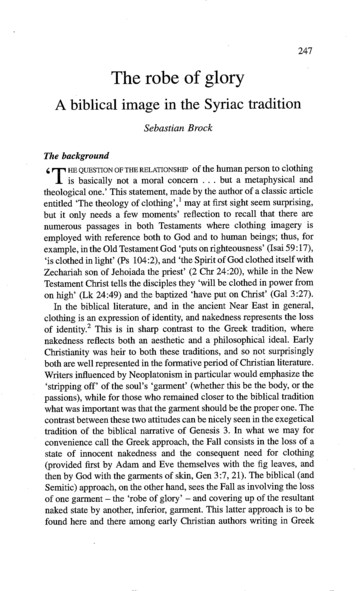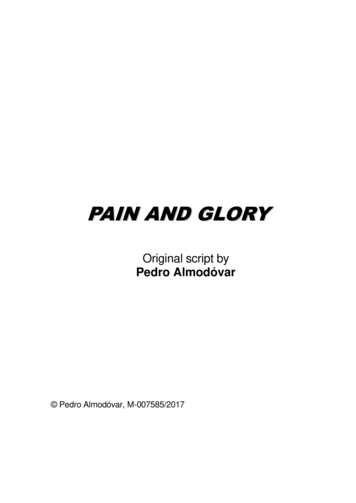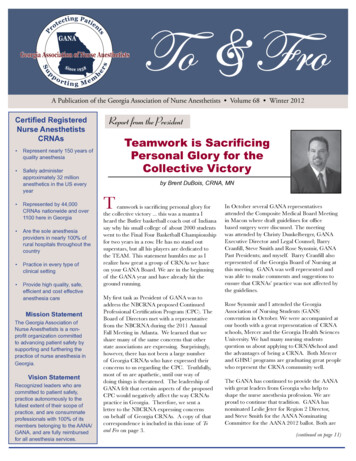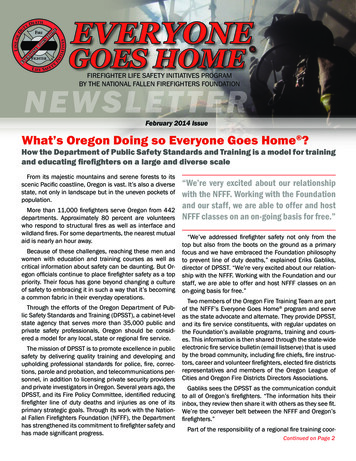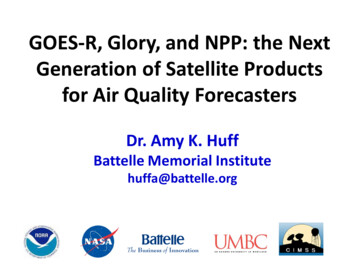
Transcription
GOES-R, Glory, and NPP: the NextGeneration of Satellite Productsfor Air Quality ForecastersDr. Amy K. HuffBattelle Memorial Institutehuffa@battelle.org
http://www.star.nesdis.noaa.gov/smcd/spb/aq/
Transition to the Next Generation of EOS Current polar-orbiting Earth-observing satellites arenear or at the end of their expected 6-year lifetimes:– Terra launched 1999 (2005)– Aqua launched 2002 (2007)– Aura launched 2004 (2010) NASA and NOAA plan to launch their next generationof satellites in the 2010-2015 time period:– Glory (NASA)– NPP/JPSS (NOAA/NASA)– GOES-R (NOAA)
Glory NASA polar-orbiting satellite with 1:30 PM overpasstime (part of A-train, 4 minutes ahead of Aura) Launch planned for late 2010 Science goals: measure optical properties of aerosolsand long-term changes in solar irradiance to determineeffects on Earth’s climate and energy balance Key air quality instrument is Aerosol Polarimetry Sensor(APS):––––9 spectral bands ranging from 0.4 to 2.4 µm1 day temporal resolution; global coverageSimilar to current POLDER instrument on PARASOL satelliteAOD with higher accuracy than MODIS but less spatialcoverage due to multi-angle measurements
NPP/JPSS NPOESS Preparatory Project/Joint Polar Satellite System Joint NASA/NOAA polar-orbiting satellite with 10:30AM overpass time (similar to Terra) Launch planned for late 2011 Science goal: transition from Terra/Aqua/Aura to JPSS Visible Infrared Imaging spectroRadiometer Suite (VIIRS):– 21 spectral bands ranging from 0.3 to 14 µm– 1 day temporal resolution; global coverage– AOD with spatial resolution similar to MODIS (400 m at nadir),but wider swath– Simulated true color images (no green band) Ozone Mapping and Profiler Suite (OMPS):– Primarily designed to measure total column O3– Aerosol index, similar to OMI (smoke and dust vs. haze)
GOES-R Next generation of NOAA geostationary weathersatellites, designed to replace current series of GOES Launch planned for 2015 Key air quality instrument is Advanced BaselineImager (ABI):––––––16 spectral bands ranging from 0.47 to 13.3 µm5 minute temporal resolutionAOD with accuracy similar to MODISAerosol type information (smoke vs. dust)Fire/hot spot characterizationVisible, IR, water vapor imagery
AWG Proxy ABI Simulations of Hurricane Katrina1.61 µm2.26 µm0.86 µm3.9 µm6.95 µm7.34 µm8.5 µm10.35 µm11.2 µm12.3 µm6.19 µm9.61 µm13.3 µmTim Schmit (NOAA/NESDIS/STAR) and Jason Otkin (UW-Madison/CIMSS)0.64 µmNOAA/NESDIS STAR and GOES-R Imagery Team0.47 µm1.38 µm
Air Quality Proving Ground (AQPG) NOAA has established a GOES-R Proving Ground – anexperimental testbed to prepare the user communityfor the new satellite products using simulated GOES-Rdata. First major technological changes to GOES since 1994,and NOAA is concerned that users won’t be preparedfor huge volume of new and improved data. The AQPG is a subset that is focusing on the aerosolproducts that will be available from the ABI. This distinction is important because the air qualitycommunity has very different needs than themajority of NOAA users, the NWS meteorologists.
AQPG Activities Goal: build a user community that is ready to useGOES-R air quality products as soon as they becomeavailable. Developing an internet delivery system for GOES-R airquality products. Will likely include NPP VIIRS/OMPS and Glory APSdata when they become available. Creating simulated GOES-R ABI products for at least10 case studies:– Past air quality events featuring haze, smoke, and/or dust– Range of locations in CONUS
AQPG Case Study 1 – August 24, 2006Terra MODIS True Color Image
AQPG Case Study 1 – August 24, 2006NOAA Hazard Mapping System
AQPG Case Study 1 – August 24, 2006NOAA GASP AOD
AQPG Case Study 1 – August 24, 2006PM2.5 24-hour Average AQI
AQPG Case Study 1 – August 24, 2006Synthetic GOES-R ABI AOD Loop from WRF-Chem Model
WRF-CHEM/CRTM ABI Synthetic Radiances (mW/m2/sr/cm-1) - 18 UTC August 24, 20060.47 µm0.64 µm0.86 µm1.38 µm1.61 µm2.25 µm3.90 µm6.18 µm6.95 µm7.34 µm8.50 µm9.61 µm10.35 µm11.2 µm12.3 µm13.3 µm
AQPG End User Group We are creating an End User Group of forecasters andanalysts who will advise us on satellite product featuresand data delivery, with a focus on GOES-R. The End User Group will continue through the launchof GOES-R in 2015. Important questions for the User Group:– What satellite products do you want to use? Many newproducts and improved versions of existing products, such asAOD, aerosol type, true color imagery, visible/IR/water vaporimagery– How do you want the products to be displayed? Eachproduct independent of the others? Overlays? Trajectories?– How do you want to access the products? Via a website likeIDEA? Do you need image files (jpeg), data files (hdf ornetCDF), and/or visualization files (geoTIFF or kml)?
AQPG Next Steps Currently forming the AQPG User Group – if you wantto influence the next generation of air quality satelliteproducts, please contact me! AQPG End User Group kick-off teleconference in lateApril or early May. 2-day AQPG End User Group workshop and training atUMBC in September (NOAA will provide travel support). For updates and more information on the ProvingGround, visit the official website hosted by CIMSS:http://cimss.ssec.wisc.edu/goes r/proving-ground.html
Acknowledgements Shobha Kondragunta, Steve Goodman,Brad Pierce (NOAA NESDIS) Ray Hoff, Hai Zhang (UMBC) Mark Green (DRI) Sundar Christopher (UAH) Fred Moshary (CCNY)
18.03.2010 · GOES-R air quality products as soon as they become available. Developing an internet delivery system for GOES -R air quality products. Will likely include NPP VIIRS/OMPS and Glory APS data when they become available. Creating simulated GOES-R ABI products for at least 10 case studies: – Past air quality events featuring haze, smoke, and/or dust – Range of locations in CONUS .
